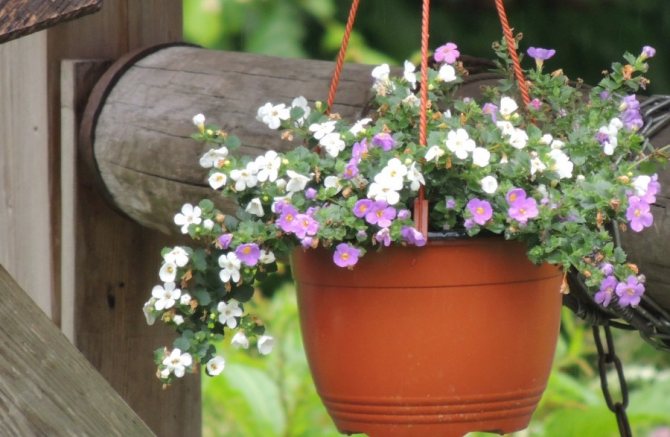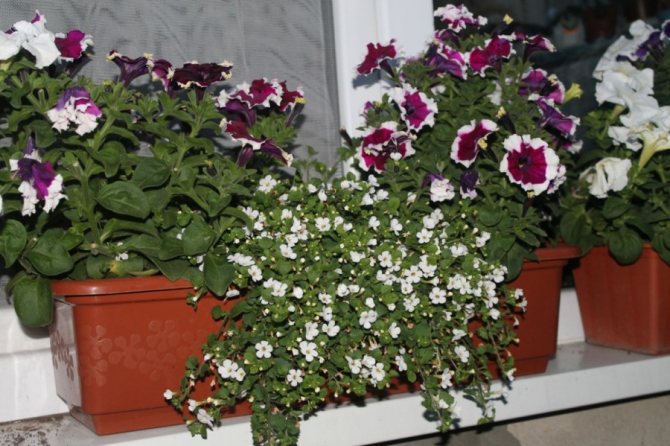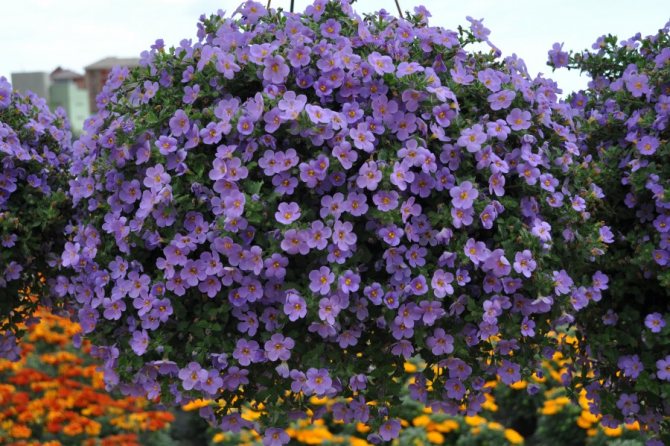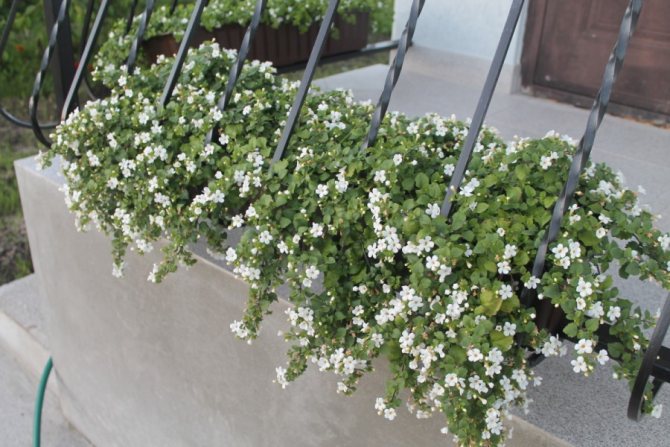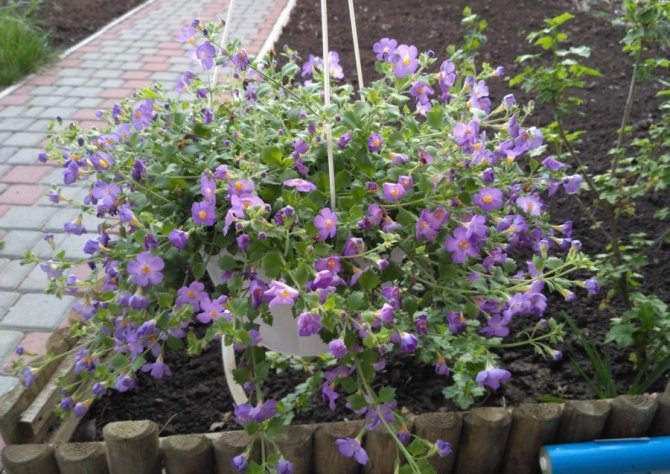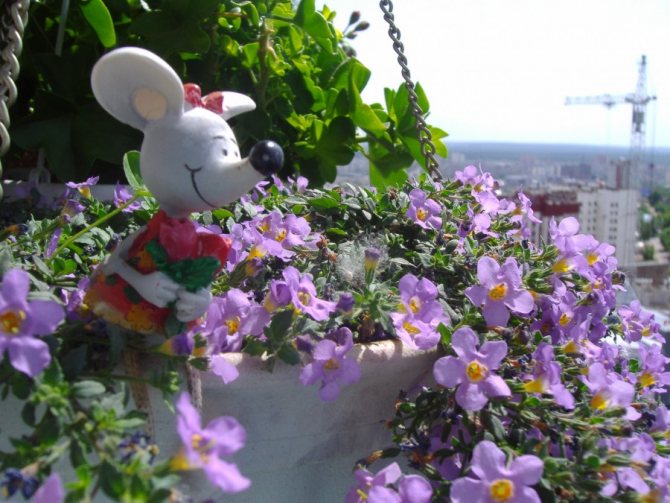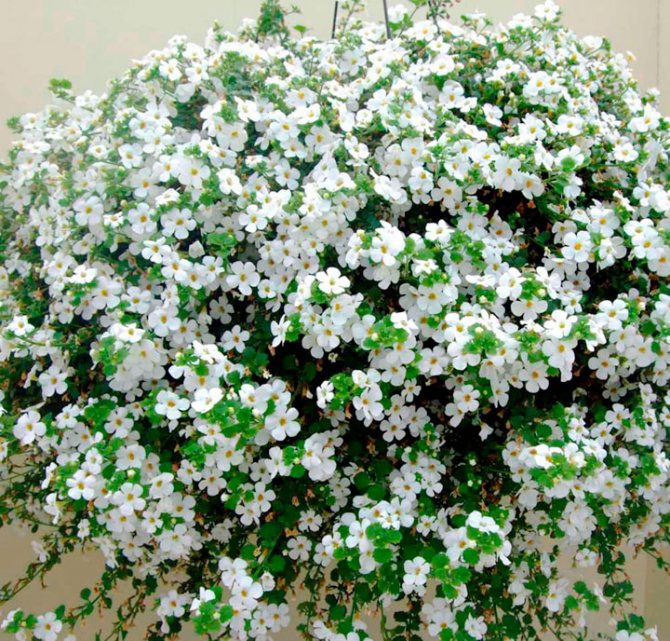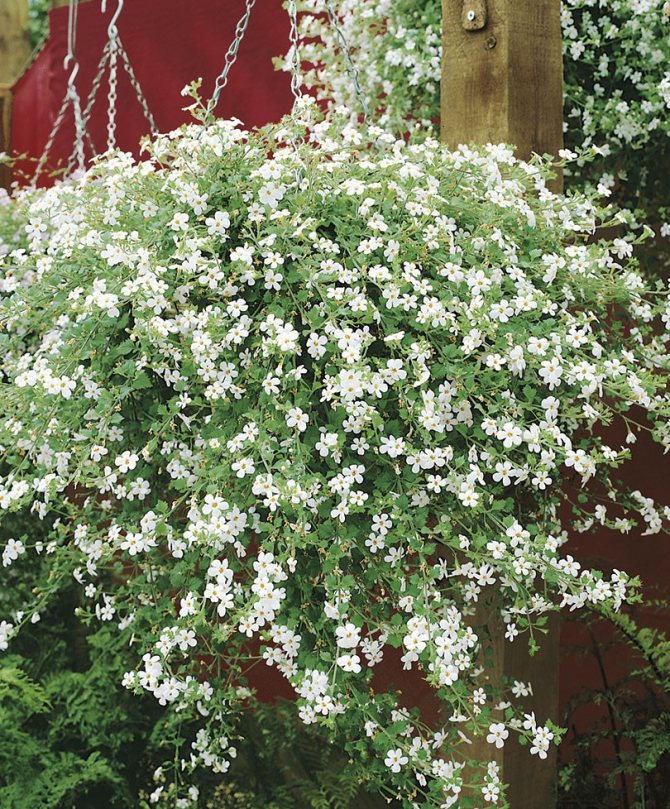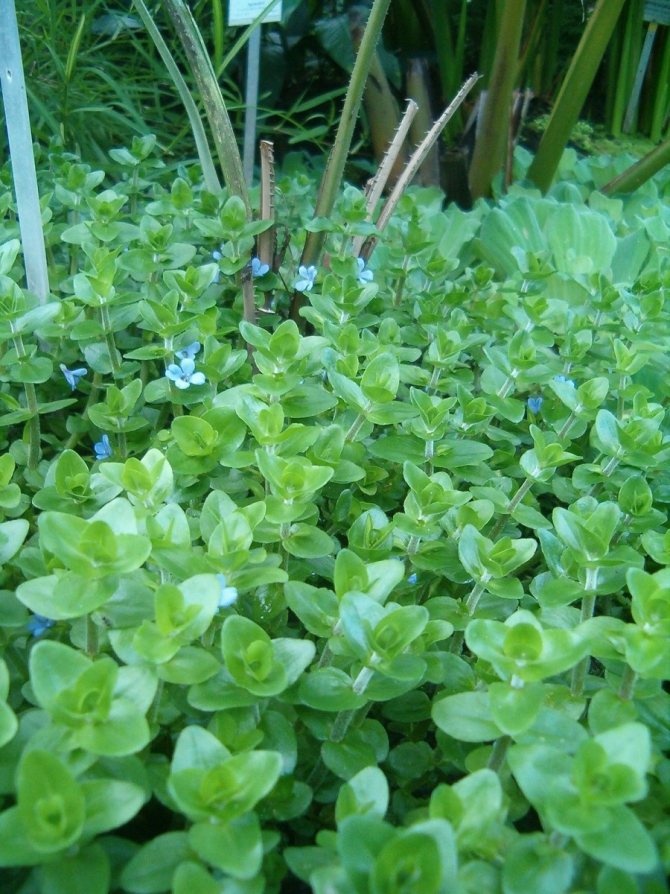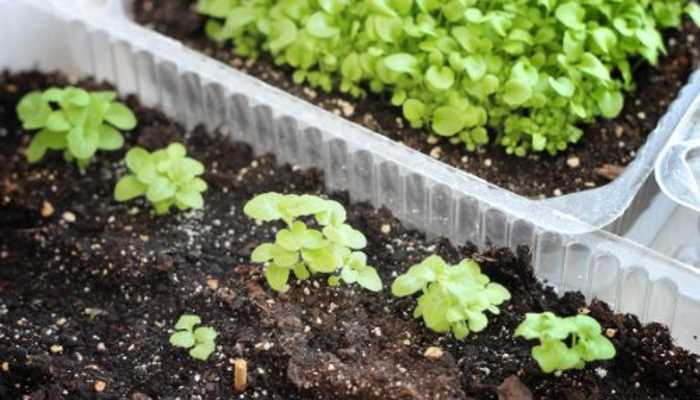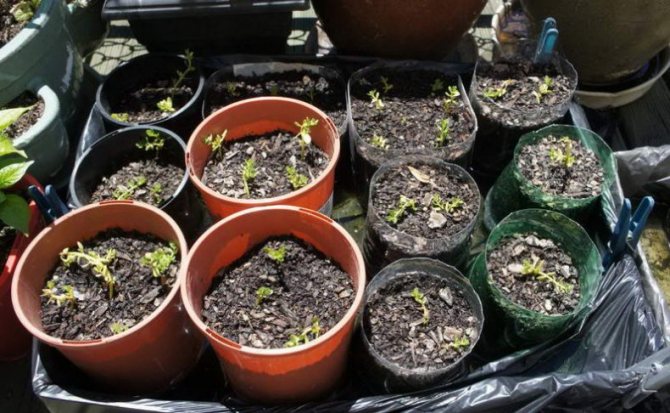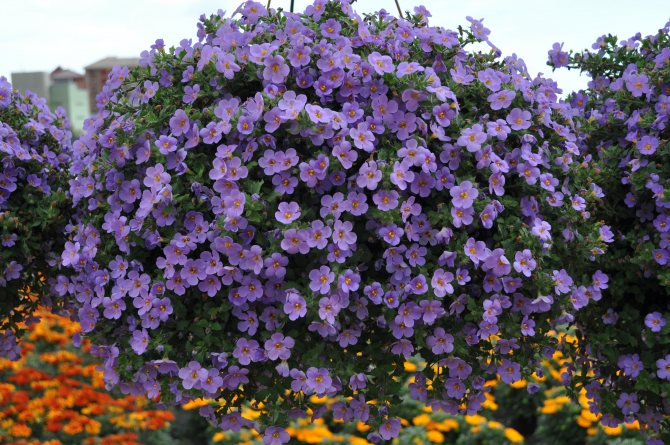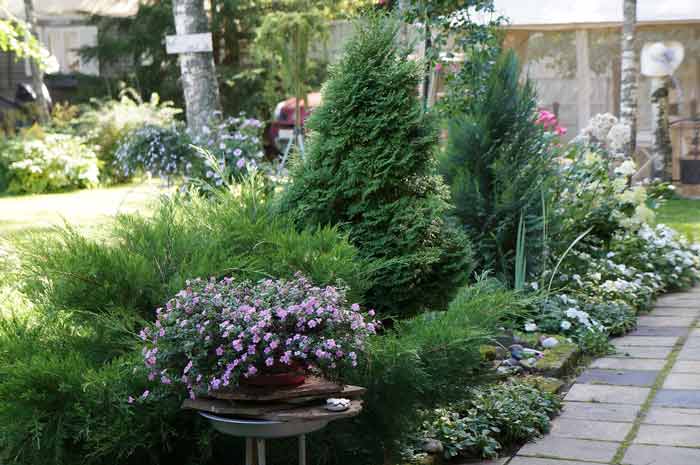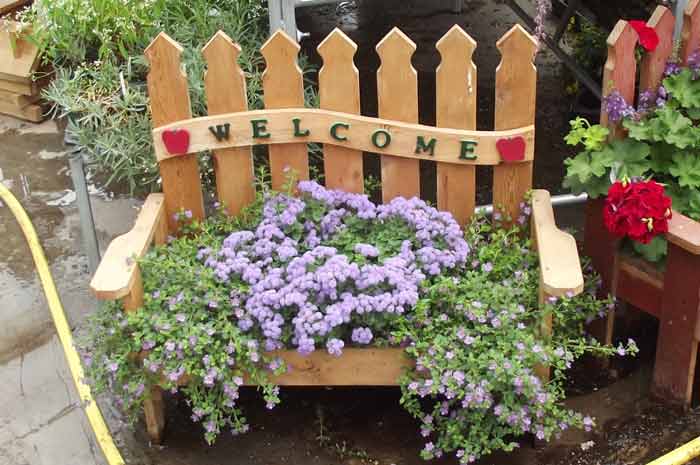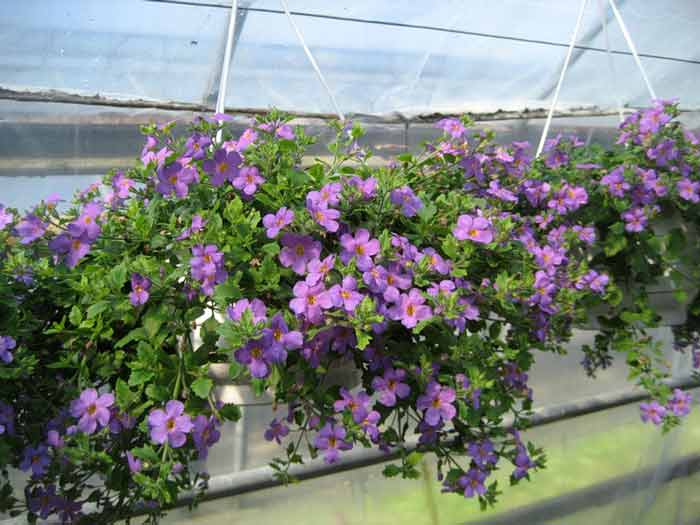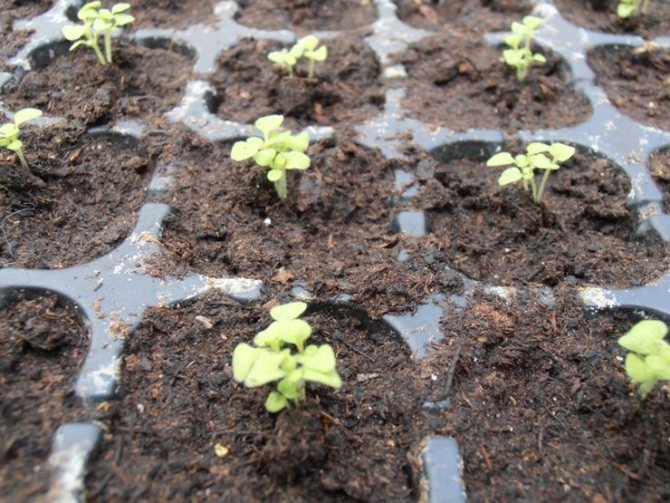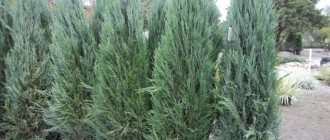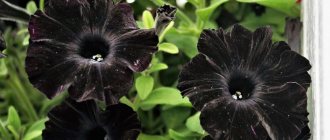Bacopa ampelous (the second name of sutera, Latin bacopa) belongs to the category of perennial creeping plants. Under natural conditions, the culture grows in tropical and subtropical climates, preferring swampy shores and wet areas. The suter is characterized by a long flowering period. Moreover, it can cover a significant area.
Shoots can reach up to 70 cm in some varieties. The suter is characterized by a short and fibrous root system. The culture has creeping stems and small, lanceolate, serrated leaves.
The flowers are solitary and quite small - about 2 cm in diameter. They can have a variety of shades - pink, white, blue, purple. There are also red and blue flowers. The culture blooms from May to October. She easily tolerates small frosts - up to -5 degrees.
Bacopa has excellent decorative characteristics. It complements flower beds well. The plant is suitable for decorating interiors and outdoor terraces. It is considered quite unpretentious, which is also its advantage.
Not devoid of bacopa and cons. One of them is the need for a sufficient amount of lighting. With a lack of light, there is a risk of active leaf development. Such a plant will not bloom.
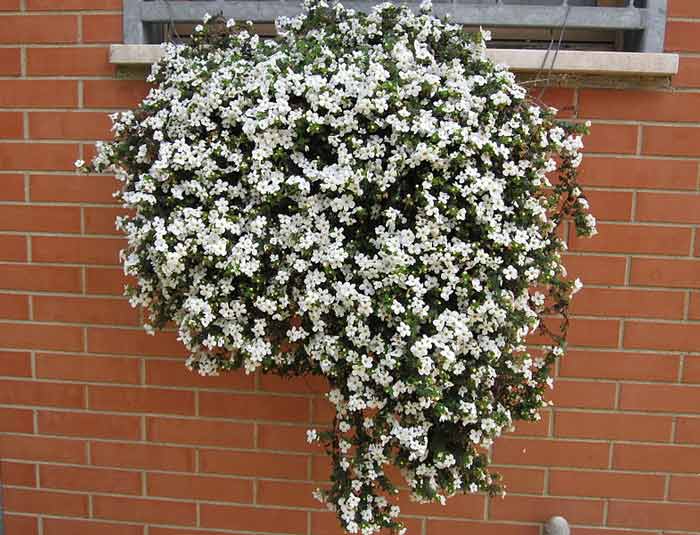
Bacopa: types and varieties for growing at home
In addition to those species that can be found in nature, there are many hybrids and varieties obtained by selection. For home cultivation, the following varieties of bacopa are common.
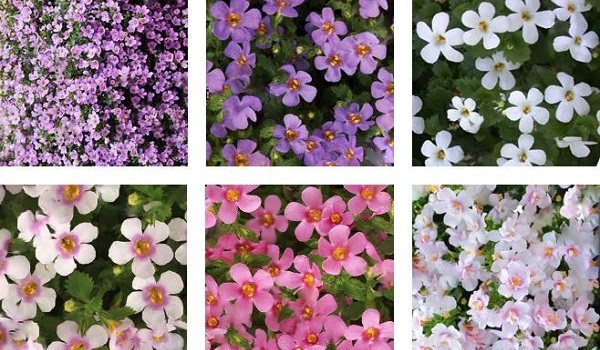

Carolina (caroliniana)
A culture from the eastern United States with erect stems 30 cm long. Oval-shaped leaves are placed criss-cross on them. When grown in the sun, the surface of the leaf plates is copper-red, in the shade it is light green. The flowers are bright blue, blooming at the ends of the shoots. The species is suitable for growing in water or near artificial reservoirs.
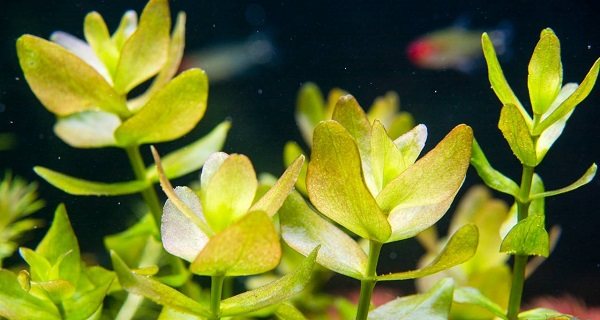

Australian (australis)
A low-growing species with thin shoots that are covered with light green leaves. They are located in pairs opposite each other. The flowers are light blue. Prefers to grow immersed in water.
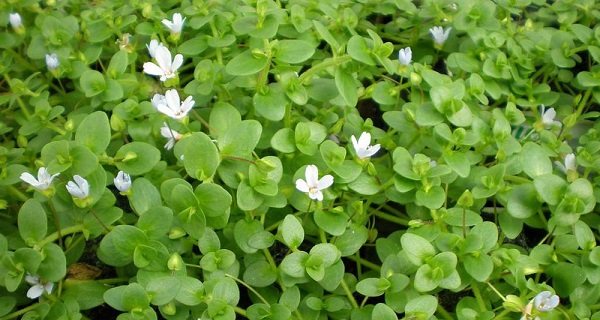

Monnieri
A succulent plant with creeping stems. The leaves are oblong, with rounded apices 0.8-2 cm long. The edges can be whole or with sparse teeth. The flowers are axillary, blue, white or purple.
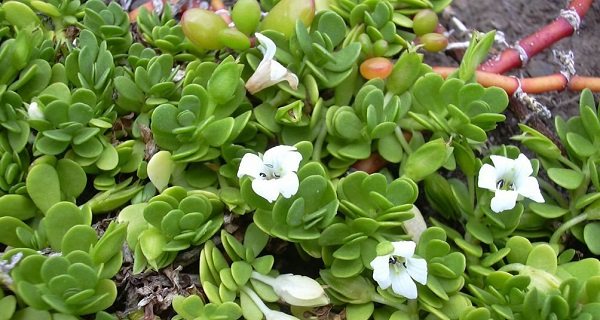

Heart-shaped (cordata)
Herbaceous, perennial plant up to 15 cm high. Leaves are green, flowers are white.
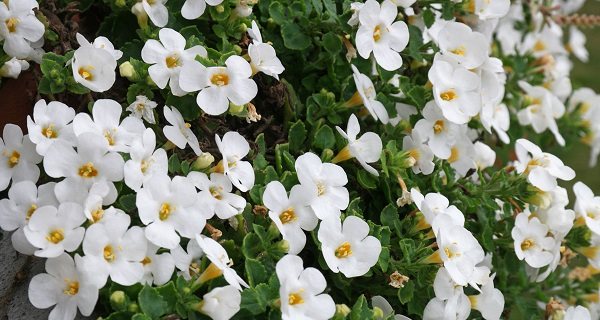

Sprawling (diffuses) or ampelous
Perennial with long thin creeping shoots. The leaves are ovoid, bright green. It blooms from May to October with multiple tubular flowers.
Popular varieties of sprawling sutra:
- Olympic Gold;
- Bluetopia;
- Scopia Double Blue.
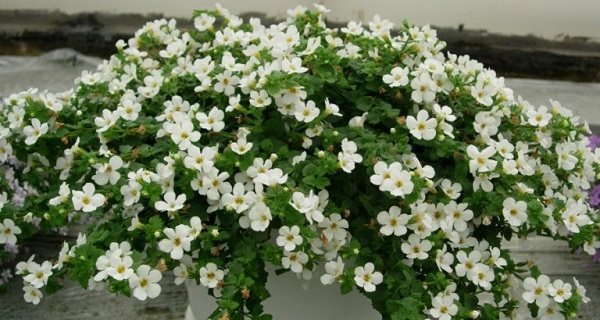

Description of the plant
Bacopa or sutera is an aquatic plant commonly found in aquariums. It comes from areas of South Africa and also grows in the Canary Islands. Ampel Bacopa is very popular in balconies and gardens.
The plant has a creeping shape. Small flowers with 5 petals grow from the corners of the leaves. There are so many flowers that the English call the bacopa snow flakes.A characteristic feature is the closure of flowers at night. The flowers are very small, depending on the variety, they are simple or double. Names such as purple and pink bacopa can often be heard, but the most common are white flowers.
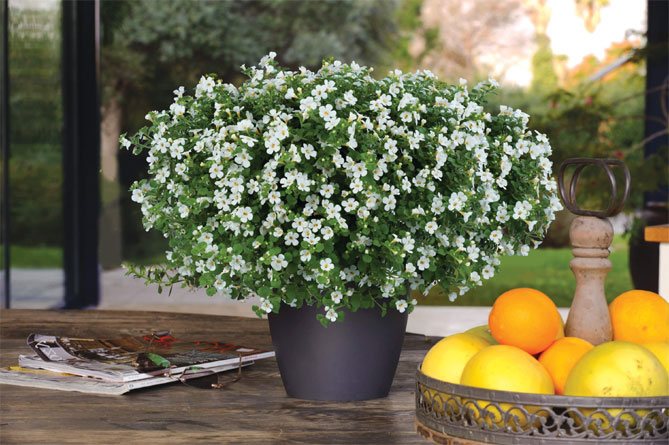

The plant has a characteristic odor that is felt only in the immediate vicinity.
a brief description of
| Characteristic | Description |
| Origin | The plant is native to South Africa, came to Europe in the middle of the 19th century. |
| Height | Due to the creeping nature, the height depends on the care, rarely exceeds 25 cm |
| Flowering date | Blooms intensively from June to mid-September |
| Stem | Creeping, creeping stems of this plant, under favorable conditions, grow up to 1 meter, densely leafy |
| Sheet | Leaves are small, heart-shaped with serrated serrated edges |
| Flower color | Blue, white, pink, with a pink eye
|
Bacopa has a beautiful hanging (hanging) shape. Its shoots are rather thin, highly branched, which creates an amazing effect when grown in hanging baskets, pots. Sutera grows very quickly at the right temperature.
Home care
Bacopa can be grown both outdoors and indoors, as an ampel or ground cover crop. Despite its tropical origin, it is not difficult to care for it. The main thing is to provide the plant with a high level of humidity, good lighting and rejuvenate it in a timely manner.
Location and lighting
Whether grown indoors or outdoors, Bacopa needs good lighting. The culture can grow in partial shade. But in such cases, it will stop blooming. In the summer, the plant, which is grown in a pot, can be taken out to the balcony, terrace, veranda.
Only sprawling and heart-shaped bacopa can take root in the garden. But in temperate climates outside, she does not hibernate. Heat-loving aquatic species are more often grown in aquariums or submerged in water.
Soil and drainage
The suter has no special requirements for the soil. But she feels best in loose, fertile soil with a slightly acidic pH.
You can prepare the soil mixture yourself by mixing:
- humus (2);
- leafy ground (1);
- sand (1);
- peat (1).
For species that grow in a pot, drainage must be provided to ensure proper drainage of water. Australian and Caroline Bacopa are used for landscaping the aquarium. They are not demanding on the purity of water and grow quickly in it.
Planting and transplanting
Bacopa has a delicate root system. Therefore, it does not need frequent transplants. When moving to a new pot or outdoors, it is best to use the transfer method so as not to injure the roots.
Transplant procedure:
- Place drainage in a pot. Sprinkle it with soil on top.
- Carefully remove the plant, place it in the middle of the pot along with the ground.
- Sprinkle with soil and tamp it a little.
- Water the bush abundantly and transfer to a permanent place.
Step-by-step video - instructions for transplanting Bacopa using the transshipment method:
Temperature
Bacopa is not afraid of temperature changes. If grown outdoors, it can stay there until the frost itself. For active growth and flowering in the spring and summer, it is better to keep it at + 23-25 degrees. It will not disappear even under hotter conditions. But you need to constantly monitor so that the soil does not dry out.
In winter, the plant rests. It should be placed in cool conditions - + 8..14 degrees. Ampel varieties can survive a short-term drop in temperature up to -5 degrees. But it’s better not to let this happen. If the bacopa has a warm wintering, its shoots will become bare and stretch, the leaves will dry out.
Watering and humidity
All types of suters are moisture-loving. They need regular watering. In summer, when the weather is hot, you need to water the flower 2 times a day (morning and evening).
Note! During the period of growing the deciduous mass, spraying is carried out 2 times a day together with watering to ensure high humidity. When flowers appear, spraying is stopped. In winter, the amount of watering is reduced.
Top dressing and fertilizers
You need to fertilize the plant only during the growing season. Bacope is suitable liquid fertilizer for flowering plants, which is applied every 10 days. To build up green mass, nitrogen content is required. It is brought in in early spring. For abundant flowering, phosphorus-potassium compounds are introduced before the beginning of budding. The plant also needs manganese and magnesium.
Flowering period
Bacopa blooms for a long period. Flowering begins in the spring and can last until October with periods of increased blooming and a decline in activity. For more lush flowering, it is recommended to pinch the shoots periodically.
The advantage of a suter is that after it has faded, there is no need to pick off dried inflorescences. Culture itself gets rid of them, discarding what is superfluous.
Pruning
For greater bushiness, it is recommended to pinch the ampelous bacopa from time to time. Too long shoots are cut off. The tops can be used to propagate the culture. You can prune the plant when the lower part of the stem begins to lignify and the flowering becomes less abundant. The stems are shortened by 1/3. The procedure is best done in the autumn after flowering. After pruning, the soil under the bacopa is watered and fertilized to stimulate growth.
Choosing a place and time of boarding
During flowering, the plant should receive a sufficient amount of sunlight. When shading the bacopa, leaves actively develop. With a lack of light, the shoots are drawn to the sun.
A slightly acidic soil is suitable for a culture. He needs to provide good drainage. To compose the substrate, you need to take 1 part of garden soil and peat and 2 parts of river sand and humus.
When to sow bacopa for seedlings
It is necessary to plant seeds for seedlings in the first half of March. If you need to sow earlier, you need to use special lamps to increase the length of daylight hours.
Reproduction methods
Sutera can be propagated in several ways.
Cuttings
It is better to harvest cuttings in late winter - early spring. Take young shoots up to 10 cm long with 2 pairs of leaves. Remove the lower leaves. Place the cuttings in water with the addition of a growth stimulant (Kornevin or Heteroauxin) for several hours. Then deepen them into a moist, loose substrate for rooting. The place of growth of the lower leaves must be sprinkled with soil. Cover the planting with foil on top. From time to time it must be removed for a short time to ventilate and moisturize the substrate.
Remove the shelter when the first young leaves appear on the cuttings. After the formation of 2 pairs of leaves, pinch the top to stimulate branching.
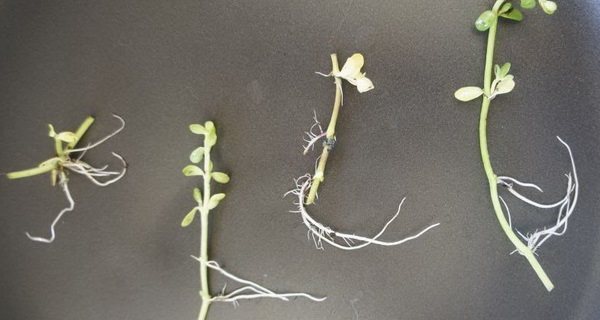

Layers
Place a container filled with substrate near the plant pot. Bend the branch and lay it out on the soil. Secure with a bracket. After a while, roots will appear on the layer. It can be detached from the parent bush. Further, it will develop as an independent plant.


Seeds
Bacopa seeds are very small. Therefore, it is recommended to mix them with sand before sowing. Prepare a fertile, lightweight substrate. Fill a container with it, moisten. Spread the seeds from above, press them a little into the ground. Cover crops with foil so that moisture does not evaporate. Transfer the container to a bright, warm place with a temperature of about +20 degrees.
Seedlings will appear in about 2 weeks. After the formation of the first pair of leaves, the seedlings dive at a distance of 2 cm from each other, deepening the lower node into the ground. For growing seedlings, the temperature should be + 23..25 degrees. When the seedlings are well grown, they can be transplanted into separate containers.If further cultivation of bacopa is planned in the open ground or on the veranda, then it is necessary to gradually harden the sprouts, accustoming them to natural aeration.
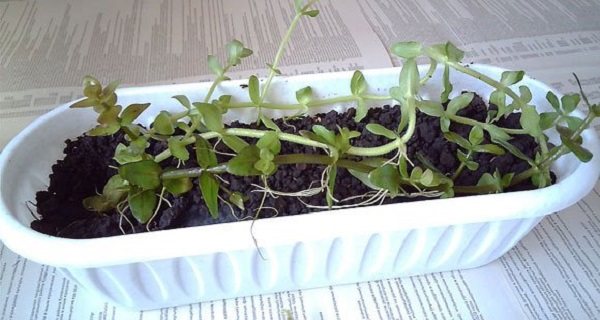

Preparing for winter
In harsh climates, it is not recommended to leave Bacopa in open soil for the winter. She just can't stand the cold. In warmer regions, it is enough to cover the bush.
In order for a plant to survive the winter, it needs to be properly cared for:
- cut off the ground part;
- move the dug out bush to a cool room;
- maintain high humidity;
- provide a temperature of about 15 degrees;
- sometimes water the plant with warm water;
- exclude fertilization.
Care errors and their elimination
Problems with growing Bacopa and methods for their elimination:
| Problem | The reasons | Decision |
| Pulling shoots | Lack of lighting | Place the container with the plant in a bright place |
| Yellowing and falling leaves | Drying soil, dry air | The soil under the bacopa should always remain moist, and the leaves should be regularly sprayed to increase the humidity. |
| Darkening shoots | Root rotting due to excess water in the soil | Do not swamp the flower, drain excess liquid from the pallet after watering |
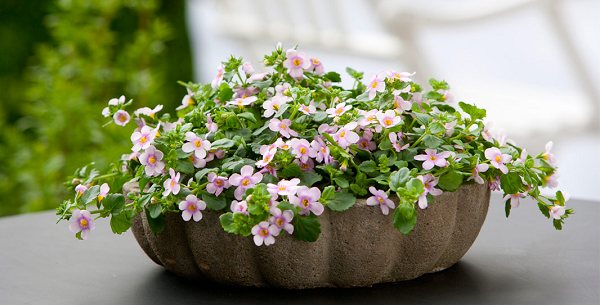

How to grow
Bacopa Carolina in captivity reproduces vegetatively, that is, by cuttings. First you need to cut off a few shoots 12-14 cm long from the top. The stems are then immediately planted in the aquarium. There is no need to wait in advance for the roots to grow back. The plant itself will take root very quickly.
It is recommended to grow Bacopa in an aquarium up to 30 cm high or other low tanks. The sprout, in contrast to the adult, must be provided with nutritious soil. Then the process will go much faster. Under good conditions, the bush will grow rapidly. It begins to bloom only in bright light and a water temperature of 30 degrees.
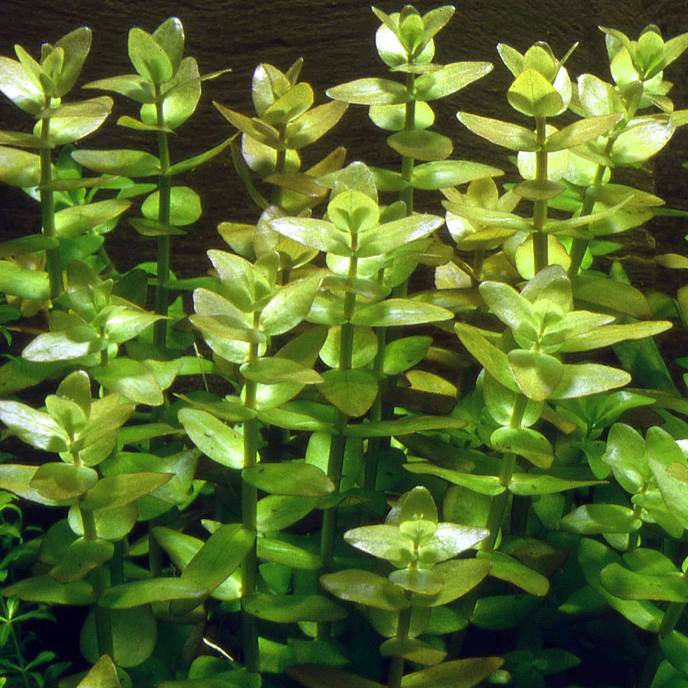

Transfer well to another tank. However, care must be taken to ensure that the water and soil parameters are the same as in the place where the bacopa grew.
Diseases and pests
If you violate the rules of agricultural technology, then the bacopa can be attacked by pests and get sick.
More often, the plant is affected by fungal infections:
- soot and mold;
- gray rot.
If a problem occurs, it is recommended to thin out the crown of the plant, remove damaged areas. Carry out 2-3 times treatment with fungicide at intervals of 10-14 days between procedures.
Bacopa pests:
- whitefly;
- aphid;
- spider mite.
To get rid of parasites, the culture must be treated with an insecticide (Aktara, Karbofos, Fitoverm). To prevent infection, you need to regulate the care of the plant.
Features of the content
Bacopa Carolina can take root well in both moderately warm and tropical climates. But if you remember that in the natural environment the plant prefers swampy soil, then a wet greenhouse or water garden would be an ideal place. In this case, the temperature should be kept within 22-28 degrees. If it is colder, then the growth of bacopa will slow down and the process of decay will begin. Soft, slightly acidic water is ideal for a plant. High stiffness leads to various deformations of the leaves, therefore dH should be in the range from 6 to 8.
The plant has one more advantage - it is not affected in any way by organic matter accumulating in the aquarium. The stems do not overgrow and mineral substances do not settle on them.
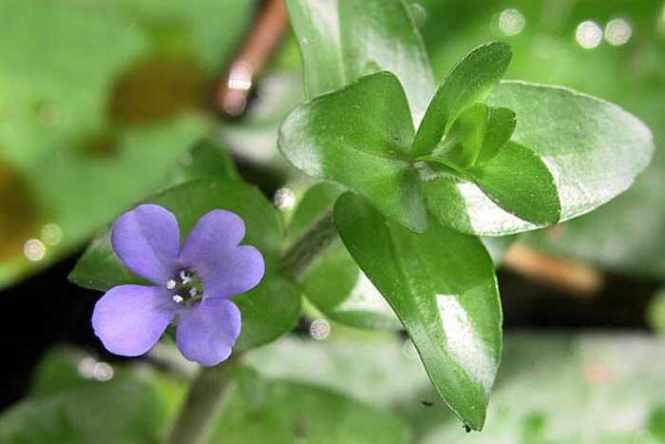

The optimal soil is sand or small pebbles, laid out in a layer of 3-4 cm. This is due to the fact that the root system of bacopa is poorly developed, and it mainly receives the necessary nutrients with the help of leaves. Be sure to make sure that the selected soil is slightly silted. Another plus of the plant is that it does not need feeding, it receives all the necessary substances from water and what remains after feeding the fish.
Lighting is the only prerequisite for good growth. If it is not enough, then the bacopa will start to hurt. Natural diffused light is ideal. If it is not possible to provide a sufficient amount of sunlight, then you can replace them with an incandescent or fluorescent lamp. Daylight hours should be at least 11-12 hours.
It is better to place the plant near the light source. It grows well in the corners of the aquarium, quickly occupying them. It is planted both in the ground and in a pot, which will then be easier to move. If you want the bacopa to spread along the bottom, then the stems just need to be pressed down with something, without damaging it. They take root quickly and turn into a green carpet. An interesting color combination can be obtained by planting different types of this plant.
Bacopa in the house: benefits and harms
The plant contains substances that have anesthetic, antioxidant, anti-inflammatory, sedative effect.
Bacopa helps:
- lower cholesterol levels;
- strengthen the walls of blood vessels;
- stimulate collagen synthesis;
- neutralize pathogenic bacteria;
- improve memory;
- reduce anxiety.
The effectiveness of the plant is manifested only in combination with other drugs. Before using formulations with bacopa, you need to consult your doctor. The plant has a number of side effects. It is forbidden to take it to children under 16 years old, pregnant and lactating women, people suffering from hypertension. Reduces the culture of the ability of men to conceive. Bacopa should not be consumed at the same time as sedatives.
Bacopa appeared in home cultivation quite recently, but has already gained popularity among flower growers. This is a beautiful moisture-loving plant that does not require complex maintenance. The medicinal properties of the flower are still poorly understood, but its decorative effect is beyond doubt. Due to the long flowering, Bacopa will become an adornment not only of enclosed spaces, but also of verandas, balconies, loggias, gardens, flower beds.
More useful information about growing, watering and spraying, the temperature of the content, as well as other nuances of caring for Bacopa can be found in the following video:
Placement in the aquarium
Due to its small size, Bacopa Karolinska is perfect for decorating even small aquariums. The main thing is to know how to properly plant and place the plant.
Experienced aquarists advise planting Bacopa in the corners of an artificial reservoir.
This is due to the fact that the plant multiplies extremely quickly, grows and, if placed in the central part or at the front walls, can take up the entire aquarium.
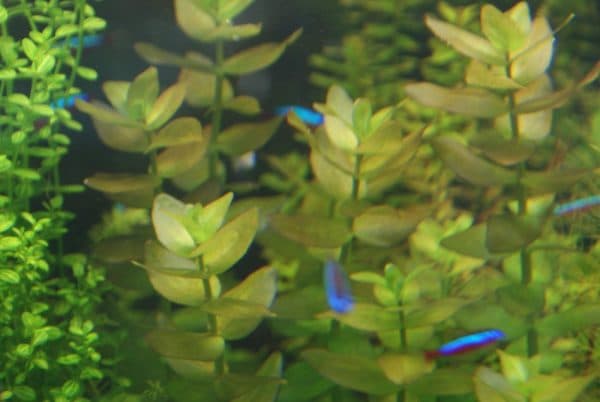

Achieving horizontal growth of Caroline Bacopa is a simple task. To achieve this goal, it is enough just to press its base with a stone during the rooting period. This manipulation will allow you to achieve the effect of the growth of bacopa along the bottom of the aquarium, which creates a beautiful decorative effect of a living green rug.
Vasilisa
The shoots of this variety are drooping, growing from 30 to 60 centimeters. The color of the flowers is special - delicate, but rather rich purple. It harmonizes perfectly in compositions with many other plants, including bright flowering ones.
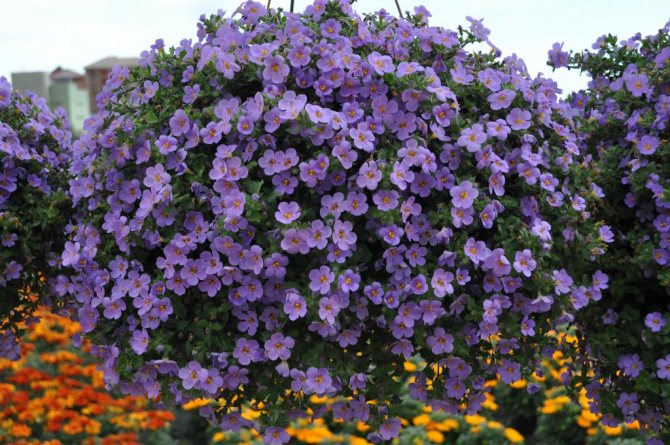

Growing Bacopa Vasilisa from seeds is possible both in areas illuminated by the sun, and in shaded areas (but not completely dark).
Reproduction of perennial bacopa by cuttings
In addition to the seed method, there is also the cultivation of suters using cuttings. For planting, apical cuttings are suitable, which should be 10-15 cm long. Cuttings are cut from an adult bush with sharp scissors and placed in a wet mixture of sand and vermiculite, taken in equal proportions. The cutting is deepened so that one internode is completely hidden in the soil, but not less than 0.5 cm. A root system will subsequently develop from it in 2 - 3 weeks.Shoots will grow from the next node located above the soil surface.
Reproduction of bacopa by cuttings is recommended at the end of summer, after pruning the bush, then you can get quite a lot of strong healthy shoots.
The stalk is removed under a glass or plastic jar, transferred to a well-lit place, but placed on a window where direct sunlight will not fall on it. In the process of germination of the cuttings, watering is carried out as the soil dries out. It should not be allowed to completely dry out or waterlogged, it should be moderately moist.
After the cutting takes root, pinch its crown so that the plant forms lush.
It has been noticed that the roots are most rapidly formed in the white varieties of the suter. In other species, the root formation process is much slower, therefore, before planting in the soil, the cuttings must be placed in a root growth stimulator.
The photo shows how the bakopa flower is taken care of after planting in open ground, all the nuances of this work are shown:
Sowing seeds for seedlings
As a rule, the seed material of bacopa is sold in granular or pelleted form, which is extremely convenient: each granule (dragee) contains 5-7 very small seeds, such material does not require any processing, and after sowing a whole bunch of sprouts appears from one hole. which in the future will turn into a real flower fountain. Many producers hide seeds of different varieties in dragees, due to which the “fountain” will be multi-colored during flowering. The sowing technology is as follows:
- The nutrient substrate for bacopa is prepared from humus, sand, leafy soil and peat (2: 2: 1: 1). The same soil composition will be suitable for pot cultivation in the future. Prerequisite: the prepared mixture for disinfection must be calcined in the oven or poured over with boiling water.
- Bacopa seeds germinate in the light, so they are not embedded in the ground, but laid out on the surface of a wet substrate and slightly pressed down.
- Crops are kept in a warm place under a film at a temperature of +20 to +23 ° C. The first shoots from the ground will appear in 2–2.5 weeks.
Blutopia
This is a beautiful annual plant, the shoots of which grow up to 60 centimeters. During the flowering period, it is covered with small blue flowers, there are a lot of them. When growing from the seeds of Bacopa Blutopia, one point should be taken into account: the sun really loves this plant! If natural light is not enough, then the shoots of the plant will begin to stretch, thin out, and with all this, flowering will completely stop.
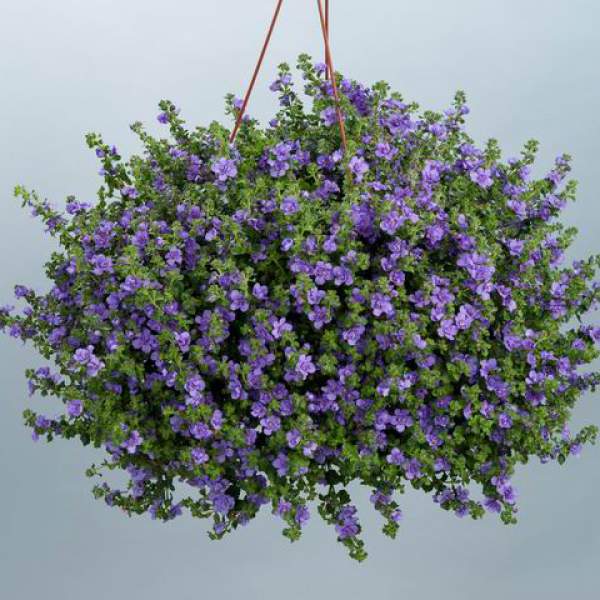

Blutopia is used for decorating gazebos, borders, as well as at home, where it looks beautiful in pots, baskets and flowerpots.
Let's summarize
The herbaceous plant Bacopa is perhaps not the easiest ornamental crop that inexperienced gardeners can begin to cultivate. However, with the proper perseverance and curiosity, as well as patience, you will go through all the initial stages of its cultivation, during which you have to make the main efforts, and only then you can relax.
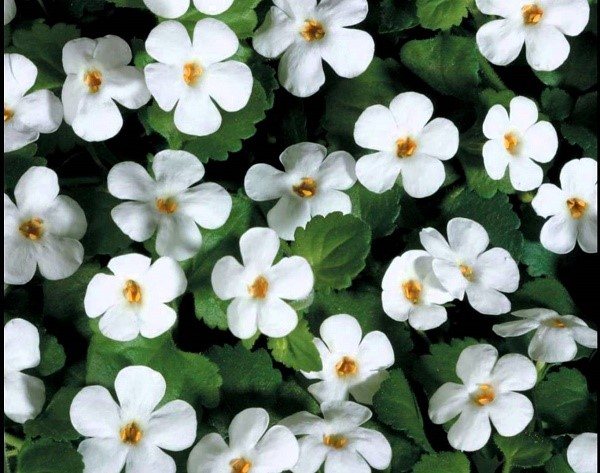

Pick your favorite Bacopa strain and grow it on your property. Believe me, even if you do not have enough experience, if you have the proper desire, everything will work out.
This plant, even at the stage of hardened seedlings, no longer shows its original capriciousness, and perfectly adapts to things such as:
- Environment;
- colder climate;
- open ground, etc.
In an adult state, Bacopa bushes are completely unpretentious. All you need is to water them and carry out other, equally simple procedures on a regular basis. And what could be even more pleasant for an avid gardener.
Rules for growing bacopa from seeds (with photo)
Propagated by sutera using seeds and cuttings. Seeds for planting Bacopa grass are collected from those plants that are already in the garden, or they can be purchased at a specialized store.For successful cultivation, certain rules must be followed.
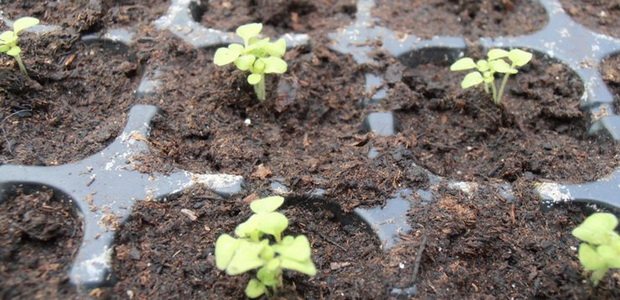

First, the seeds are planted on seedlings, which, after they grow up and get stronger, are placed in a permanent place in the garden. This work is carried out in the first decade of March. For sowing, take a peat soil mixture and place it for disinfection in an oven heated to 100 degrees, where it is kept at this temperature for 3 to 4 hours. The disinfected soil is poured into pots, the seeds are evenly distributed over its surface, slightly pressing them. The crops are covered with plastic or glass and placed in a warm, bright room. Crop care consists in periodically moistening the soil and ventilating them. Sprouts will begin to appear under these conditions in 10 to 14 days.
The picking of seedlings into peat pots is carried out after they have 3 full leaves. Grown plants are fed with mineral fertilizers. Seedlings are grown at a temperature of 24 - 26 degrees, carrying out systematic care for it in the form of watering and loosening the earthen coma.
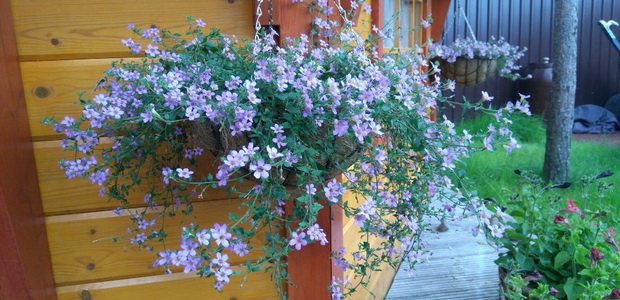

If the gardener plans to breed Bacopa on the site, he will need to make another dive into a pot slightly larger than the previous one. A week after the repeated picking, young plants should be fed with nitrogen and phosphorus containing fertilizers. You can keep seedlings outdoors during the day, and bring them indoors at night. So the plants will gradually harden and take root better in open ground conditions.
Bacopa seedlings are transplanted to the site in the second half of May, when warm weather sets in. Before planting, holes are prepared at a distance of 25 - 30 cm from each other. Seedlings are placed in the holes, covered with soil, tamped around the area and watered abundantly.
How the bacopa plant is grown from seeds can be seen in the photo below, where this work is shown in stages:
Bacopa carolina
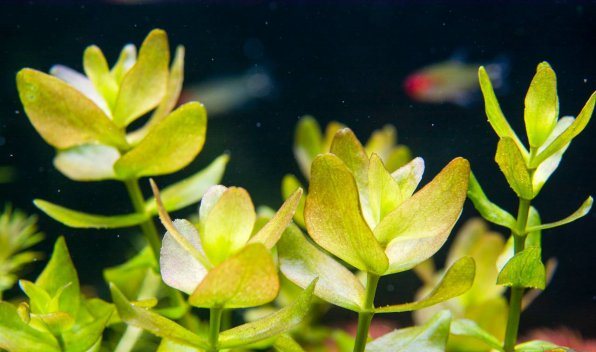

Bacopa carolina photo
Bacopa caroliniana is a perennial, creeping plant with juicy stems and leaves arranged in pairs. North America is considered the birthplace of this aquarium plant. Bacopa can grow in both salt water and fresh water, therefore it is used for landscaping marine and freshwater aquariums. And also shoots of Bacopa Karolinska are able to grow beyond the water level and bloom on the surface. Bacopa flowers are delicate, small, light purple with five petals. The leaves have a greenish-yellow tint, but under increased lighting, the upper shoots can take on a copper-brown or pinkish color. Coloring occurs when there is a sufficient amount of iron and trace elements in the water. With a metered supply of CO2, the leaves will be noticeably thicker and larger. When rubbing the leaves between the fingers, Bacopa Carolina gives a subtle scent of lemon mint.
Care and reproduction of Bacopa Karolinska. Since the growing conditions of this plant are very simple, and Bacopa is perfect not demanding in care, therefore it has become a very popular landscaping among aquarists. So, you can grow Bacopa in an aquarium both in special soil and in rocky soil and sand. Just in the soil with nutrients, the plant will be healthier, the leaves and stems are thicker. For reproduction of bacopa, it is necessary to cut off the long tops of the plant and plant it with a bush in the ground. After pruning, the mother plant will sprout lateral shoots and begin to bush even harder. After several pruning cycles, the mother plant will become very thick and not very attractive, but this is very easy to fix by cutting off the side shoots, removing the mother plant altogether and replacing the cut cuttings in the place of the old plant. Bacopa Caroline thrives in tall aquariums, its brownish upper leaves adorn its appearance, giving a brown hat to all the inherent greenery.Bacopa has been growing in my 250 liter aquarium for 3 years. The upper stems with leaves became almost brown in color, and I just cut them off, as they began to shade the bottom very much, and a lot of algae accumulated on them. And due to the lack of light, the lower leaves began to fall off, and the plant looked unattractive. So I just removed the mother plant and planted brown cuttings. Very quickly, they gave roots and anchored in the ground on their own. This very beautiful aquarium plant needs frequent liquid fertilization and is best planted in the background due to its tall growth.


All of the above is just the fruit of observing this type of aquarium plant and collecting various information from owners and breeders. We would like to share with visitors not only information, but also lively emotions that allow us to more fully and subtly immerse ourselves in the world of aquaristics.
Location
When choosing a place for planting bacopa, preference should be given to areas that are brightly lit by the sun or located in light shade. In more shaded places, the shoots of the African beauty are strongly elongated, and the flowering becomes scarce and expressionless.
The culture is less demanding on soils, but it feels especially comfortable on aerated, slightly acidic fertile soils. If the soil in the selected area is not very nutritious, it is recommended to add peat or humus for digging at the rate of 4–5 kg / m2.
Snowtopia
In addition to its beauty, this plant is completely unpretentious. The only thing is to ensure its landing in places where direct sunlight does not penetrate.
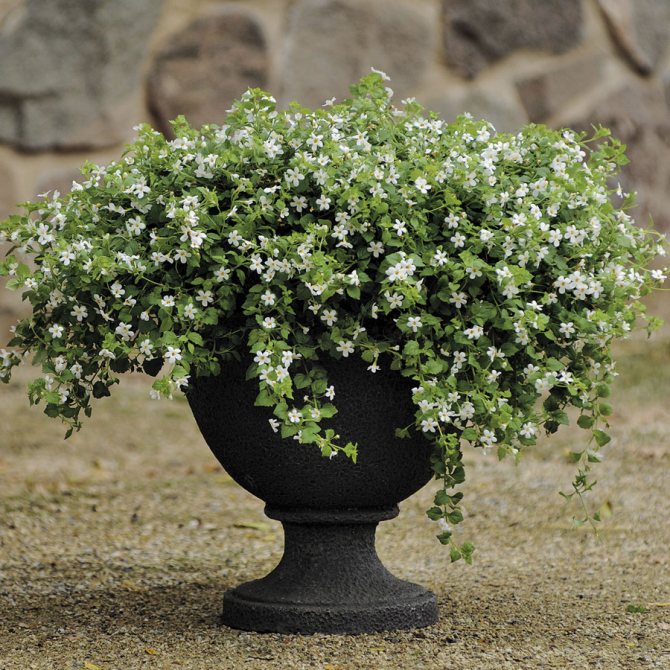

When in bloom, Snowtopia resembles a large ball of flowers. The shoots of this plant can grow up to 60 centimeters, the flowers are white. This bacopa is perfect for growing in baskets and flowerpots, it is in harmony with other flowering and non-flowering plants.
Summer flower care
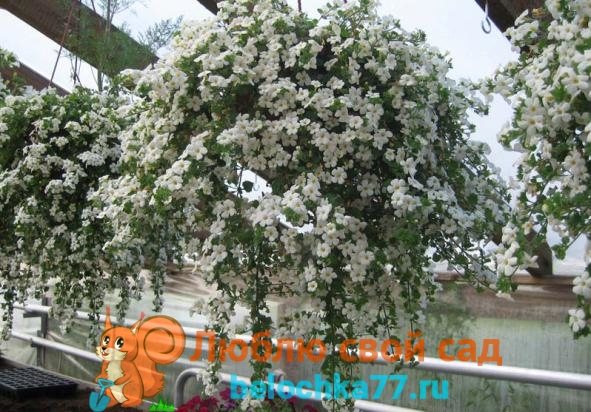

Caring for your bacopa is easy. The plant is unpretentious, it requires compliance with just a few simple conditions.
- The first is proper watering. Bacopa likes a lot of moisture. Therefore, it must be watered abundantly and often. Especially if the weather is dry and hot outside. Only if there is a sufficient amount of moisture will this plant be spreading, lush and can bloom for a long time.
- The second condition is feeding. It needs to be done about 3-4 times throughout the season. This plant does not require any special fertilizers. A simple complex remedy for plants that bloom is quite suitable.
- And one more important point is pinching. The fact is that the beauty of the bacopa bushes needs to be slightly adjusted. Some shoots can grow too long, then the aesthetics of the flower is lost. It is best to pinch the branches when they reach a length of 50-60 cm. This is especially true for plants that have "settled" in hanging flowerpots. If the bushes are properly formed, then the bacopa will resemble a beautiful and lush blooming ball.
In fact, this is all care. If it is necessary to remove wilted inflorescences from some flowers, then in the case of bacopa, everything is much simpler. The plant independently sheds the buds that have faded. In their place, new fresh flowers grow.


